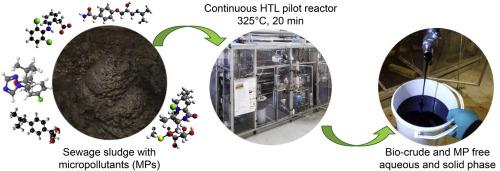Water Research ( IF 12.8 ) Pub Date : 2020-06-24 , DOI: 10.1016/j.watres.2020.116101 Lars Bjørn Silva Thomsen 1 , Pedro N Carvalho 2 , Juliano Souza Dos Passos 1 , Konstantinos Anastasakis 1 , Kai Bester 2 , Patrick Biller 1

|
The beneficial use of sewage sludge for valorization of carbon and nutrients is of increasing interest while micropollutants in sludge are of concern to the environment and human health. This study investigates the hydrothermal liquefaction (HTL) of sewage sludge in a continuous flow pilot scale reactor at conditions expected to reflect future industrial installations. The processing is evaluated in terms of energy efficiency, bio-crude yields and quality. The raw sludge and post-HTL process water and solid residues were analyzed extensively for micropollutants via HPLC-MS/MS for target pharmaceuticals including antibiotics, blood pressure medicine, antidepressants, analgesics, x-ray contrast media, angiotensin II receptor blockers, immunosuppressant drugs and biocides including triazines, triazoles, carbamates, a carboxamide, an organophosphate and a cationic surfactant. The results show that a positive energy return on investment was achieved for all three HTL processing temperatures of 300, 325 and 350 °C with the most beneficial temperature identified as 325 °C. The analysis of the HTL by-products, process water and solids, indicates that HTL is indeed a suitable technology for the destruction of micropollutants. However, due to the large matrix effect of the HTL process water it can only be stated with certainty that 9 out of 30 pharmaceuticals and 5 out of 7 biocides products were destroyed successfully (over 98% removal). One compound, the antidepressant citalopram, was shown to be moderately recalcitrant at 300 °C with 87% removal and was only destroyed at temperatures ≥325 °C (>99% removal). Overall, the results suggest that HTL is a suitable technology for energy efficient and value added sewage sludge treatment enabling destruction of micropollutants.
中文翻译:

污水污泥的水热液化;中试规模处理过程中的能源考虑和微污染物的结局。
污水污泥用于碳和养分增值的有益用途受到越来越多的关注,而污泥中的微量污染物则对环境和人类健康至关重要。这项研究调查了在连续流中试规模反应器中污水污泥的水热液化(HTL),其条件有望反映未来的工业设施。根据能效,生物粗品产量和质量对加工进行评估。通过HPLC-MS / MS广泛分析了原始污泥,HTL工艺后的水和固体残留物中的微量污染物,以分析目标药物,包括抗生素,血压药物,抗抑郁药,镇痛药,X射线造影剂,血管紧张素II受体阻滞剂,免疫抑制剂药物和杀生物剂,包括三嗪,三唑,氨基甲酸酯,羧酰胺,有机磷酸酯和阳离子表面活性剂。结果表明,在300、325和350°C的所有三个HTL处理温度下均获得了正的能量投资回报,其中最有利的温度确定为325°C。对HTL副产品,工艺用水和固体的分析表明,HTL确实是销毁微污染物的合适技术。但是,由于HTL工艺用水具有较大的基质效应,因此只能确定地说,成功销毁了30种药品中的9种和7种杀生物剂产品中的5种被成功销毁(去除率超过98%)。一种化合物,抗抑郁药物西酞普兰,在300°C时具有中等难降解性,去除率达87%,仅在≥325°C(> 99%去除率)时被破坏。总体,



























 京公网安备 11010802027423号
京公网安备 11010802027423号